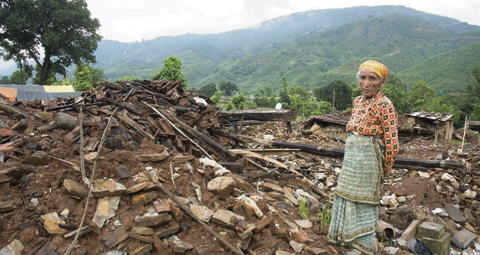May 6 | ![]() 0 COMMENTS
0 COMMENTS ![]() print
print

Scots saved lives after Nepal quake
Alistair Dutton, director of SCIAF, reports from Nepal from his visit on the first anniversary of the devastating earthquake. He witnessed first-hand the progress that is being made and sees the long road to recovery that still lies ahead
Kathmandu has changed in many ways. When I was here 20 years ago, as a Jesuit novice working with refugees from Bhutan, it was a seductive maze of charming streets, littered with colourful Hindu temples and Buddhist shrines, small hotels and bars, where people gathered to plan their treks up into the mountains, or reminisce about the adventures they’d just had. Today, it has grown immensely: high rise buildings fill the valley, and cars and motorbikes swarm down every street, cramming to get through the jams and queues.
Despite the frenetic hustle and bustle that I associate more with the big cities of India or Bangladesh, echoes of the gentler pace of the past still catch the eye as you pass through the city. In one place, without the normal sounds of horns, all the vehicles patiently wait for a blind man to tap his way across four lanes of traffic to cross the road. In another calves lie on the grass verge in the middle of the dual carriageway, silent reminders of the importance attributed to cows and Ram in Hinduism. Barrow boys push their carts, loaded with colourful clothes and jangling with pans. Shrines on the rivers for the cremation of the dead poignantly symbolise the cycle of life while elegant Buddhist stupas and Hindhu temples maintain a serenity amidst the cacophony that fills the air.
As I drank all this in driving from the airport when I arrived, I was saddened to see many many signs of the damage that was caused by the devastating earthquake a year ago, and heartened by the progress that has been made since. When I first heard a serious earthquake had hit Nepal, I was dismayed to imagine the impact on this beautiful country, rich in culture and history, and the terrible human tragedy that had occurred.
The 7.8 magnitude earthquake killed nearly 9000 people and left a million survivors in need of immediate help. Even before the earthquake, Nepal was one of the poorest countries in the world, with over 75 per cent of its people dependent on farming, livestock and casual labour to earn a living. According to the World Bank the earthquake and aftershocks pushed another 700,000 people into poverty. The Nepali Government estimated that the disaster led to the financial loss of over US$7billion.
As soon as the earthquake happened Caritas Nepal was out in the streets with the people, and very quickly was able to give them tarpaulins, blankets and jerry cans so that they could cope for the next few nights. The group swiftly organised its response and began to get out into the surrounding areas. Many of the survivors were cut off in very remote, mountainous areas, and the destruction of roads, public buildings, communications networks and other vital infrastructure meant that it took several weeks to form a clear picture of the devastation and reach many villages. Co-ordination between Caritas Nepal and many other organisations ensured that as many lives as possible were saved in the immediate aftermath.
Visiting Chandenimandan, about two hours from the capital city of Khatmandu, I met Chari Majhi. She told me how she had lost both her parents in the earthquake. With her husband away, working as a farm labourer in India, her four children and friends in the village quickly rallied round to help her cope with her loss but Chari described how still, when she is eating, she remembers her Mum and Dad, and finds herself weeping for them.
Chari was full of gratitude to Caritas (and SCIAF) because they were the first to reach her village with help. Caritas provided corrugated iron to repairs the roofs of the houses, food for them to eat in the first few weeks, and fast-growing seeds for them to harvest quickly.
With the help of SCIAF supporters and the Catholic Church worldwide, Caritas agencies were able to get relief to more than 350,000 people in the first four months. Thanks to supporters’ generosity, SCIAF contributed £200,000 to Caritas’ immediate response.
While I was in Chandenimandan I also met Shahdev Majhi. Shahdev’s eyes were pools of sadness and he told us how he had lost his only son, aged 18, in the quake. Rightly, the main focus of the aid effort after natural disasters is on people’s most basic needs—food, water, shelter, bedding, clothing, and so on—but often the grief and psychological pain is overlooked. As Shahdev and others in the village spoke to me, they told me how much they appreciated the way Caritas accompanies them, providing friendship and care alongside the material assistance, reflecting an integrated approach to human development that tries to provide for more than people’s physical needs.
Once people began to have what they needed to live day -to-day, attention quickly turned to longer-term reconstruction of people’s homes, communities and and helping them earn a living.. .
Everywhere I went people told me that their first three priorities are shelter, water and earning a living. As in most natural disasters the poorest people suffered most in the earthquake. Many of their houses were poorly built out of mud and stones, which simply shook apart when the earthquake happened; irregular stones rolled off one another when the mud couldn’t hold them and the walls disintegrated, falling on the people inside.
People in the villages live a very hand-to-mouth existence and they have no savings with which to rebuild their homes. The compensation the Nepalese government will provide, Caritas’ work to makes sure people get what they are entitled to, and the support from Caritas will be essential to help people—particularly the poorest and most marginal—resume their lives.
So great was the earthquake that many new cracks were formed in the land, causing underground streams to find new courses and many springs to dry up.
Water sources in a lot of villages are dry now and people have to walk long distances to get water. For many this now takes several hours a day. Most of the burden falls on women and children, and it’s nigh on impossible for the elderly or infirm.
As one teenager passionately said: “Water is life, and without water, shelter is pointless.”
Thanks to Scottish generosity, SCIAF raised over £659,000. The remaining £459,000 is going towards Caritas Nepal’s three-year, 18-month programme to construct village water systems and over 4,600 earthquake-resistant homes, and help some 5000 families earn a living. People will gain the skills and the materials to ‘build back better,’so that if (and in all likelihood when) disaster strikes again they will be better prepared. Once again the unity and strength of the Caritas family worldwide meant the national Caritas—Caritas Nepal—was able to respond quickly to provide many people with the help they urgently needed, and will continue to help them resume their lives.
The situation for many people in Nepal remains very difficult, but people who have faced unbelievable destruction and the loss of loved ones, are courageously rebuilding their lives. Time and time again I am humbled by the courage, hope and strength of people in the worst of situations. I am proud that the support of the Scottish people saved lives 12 months ago, and continues to help people and give them hope through the long process of reconstruction.
—Alistair Dutton is the director of the Scottish Catholic International Aid Fund (SCIAF).
Pic: CAFOD Bikash Khadge











